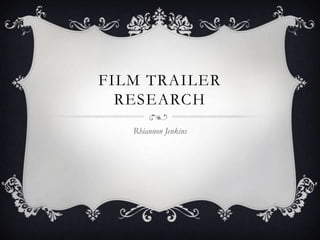
Film trailers
- 2. FILM TRAILERS A film trailer is an advertisement for a feature film that will be shown in future at a cinema. The term “trailer” comes from the previews originally being shown at the end of a feature film. However, audiences usually tended to leave the cinema before these were shown so the trailers were moved to be previewed before the films themselves, however the term “trailer” still stuck.
- 3. TYPES OF TRAILERS Film trailers are not just shown in cinemas any more, but are accessible on DVD and Blu-Ray as well as on the internet and via mobile devices. There are two main types of trailers. The first is a teaser trailer which is roughly a minute long and is what first captures the audiences attention. The second type is a traditional trailer which is longer and tells more of the story and is typically shown after the audience has seen the first trailer. Trailers are not only confined to films any more as there are now many video game and television series trailers.
- 4. TRAILER COMPOSITION Film trailers tell a story in a highly condensed fashion whilst containing as many scenes that are appealing to the audience as possible. They often consist of three sections, much like the structure of a feature length film itself: the first section sets the scene, the second drives the narrative further and the last contains a massive climax usually accompanied by dramatic music, scene montages and sometimes a cast run through if they are notable enough. All movie trailers now contain shots called the “money shot”. These shots are the biggest and most captivating shots for the audience such as the explosion of the White House in Independence Day. Trailers contain as many of these shots as they need to in order to gain the audiences attention.
- 5. TRAILER COMPOSITION Voice over narration can be used to briefly explain when necessary and helps the audience to stay on track with the trailer as it is still highly condensed. Music is used to help set the mood and tone of the film. The music does not necessarily have to be from the film itself but can be popular music, music from other film soundtracks, specially composed music or “library music” which was previously composed specifically to be used in advertisement. Most trailers conclude with a billing block of the main cast and crew, and notable actors or directors/producers are often mentioned during the trailer to attract audience attention.
- 6. ROM-COM TRAILERS Typical conventions of rom com films which are also found in the trailers are: a couple, romantic scenes and locations, several plots at once, stereotypes and comedy. They will often contain lighthearted music that fits the mood of the narrative. An example where all of the above can be found is in the trailer for Crazy Stupid Love, which I have added to be played after this slide.
- 7. ACTION FILM TRAILERS Action film trailers are generally very big and include lots of explosions, weapons, fighting and big machinery. Many action film trailers start off with a brief introduction to the film and its premise but move swiftly on to show the destructive and high energy parts of the film. A good example of an action film trailer is Elysium:
- 8. HORROR FILM TRAILERS Horror film trailers are generally edited very carefully and move at a very fast pace which unnerves the audience and opens them up to the dark side of life without them being harmed. They will often contain dark music and dark locations and are usually centered around the alien, supernatural or the evil that lives within society. A brilliant example of a horror film trailer is Nightmare On Elm Street (2010):